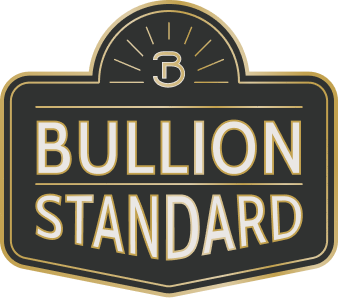The Role of Inflation in Driving Bullion Market Trends
By Bullion Standard ·
6 min read
Inflation is a reality that affects everyone—whether you’re buying groceries, paying bills, or managing your investment portfolio.
As the cost of living rises, the value of cash in your wallet diminishes. However, physical gold often moves in the opposite direction, becoming more valuable as prices increase. But what drives the gold and inflation relationship?
At Bullion Standard, our mission is to empower you with the knowledge to make informed financial decisions. In this blog post, we’ll break down how inflation shapes bullion market trends and what that means for your investments.
What Is Inflation?
Inflation is the increase in the cost of goods and services over time. When inflation goes up, the value of currency goes down. This means that the same amount of money buys fewer goods or services.
Central banks typically try to control inflation by adjusting interest rates. Despite this, inflation can still fluctuate due to a variety of factors, like supply chain issues or changes in consumer demand.
How Does Inflation Affect Gold Prices?
An increase in inflation means rising prices all around: grocery bills go up, energy costs rise, and suddenly, your money doesn’t go as far as it used to.
This is why many investors turn to gold during inflation. Gold has always been considered a “hedge” against inflation—meaning it protects your wealth from losing value as prices rise.
The reason is simple: while cash loses purchasing power during inflation, gold typically holds or even increases in value. As inflation goes up, so does the price of gold, making it a reliable asset to help hedge inflation and balance out the effects of a weaker dollar.
Historical Examples of the Gold and Inflation Relationship
Looking at history, we can see that gold prices began to rise during times of high inflation.
The 1970s: Gold Soars Amid High Inflation
The 1970s were a time of economic turmoil in the U.S., marked by skyrocketing inflation. Factors such as the oil crisis and changing monetary policies contributed to inflation rates climbing into the double digits.
During this time, gold prices soared, reaching record highs by the end of the decade. Investors flocked to gold as a safe haven, and it became a symbol of wealth preservation during one of the most challenging inflationary periods in recent history.
The Early 2000s: Inflation Concerns Drive Gold Demand
While inflation wasn’t as dramatic in the early 2000s as it was in the 1970s, concerns over rising prices and economic uncertainty still led to increased demand for gold.
Factors such as rising oil prices, geopolitical tensions, and fears of future inflation pushed investors toward safe assets like gold. From 2001 to 2011, gold investing saw a steady increase in price, peaking during the global financial crisis as inflation fears took hold.

Gold and Inflation Relationship: Key Variables
How Inflation Affects Gold Demand
When inflation reduces the value of currency, investors often seek more stable alternatives to protect their wealth.
Gold, in particular, sees increased demand during periods of rising inflation, as it is viewed as a reliable store of value. Its historical ability to maintain or even grow in value during inflationary times makes gold a reliable inflation hedge.
Inflation Fears Drive Bullion Market Trends
Inflation worries can send investors looking for safer assets, with gold and precious metals often topping the list.
In fact, gold demand can increase before inflation rates actually rise. This is because many investors act early by monitoring inflation signals—using data from consumer price indexes or central bank policies.
This pattern strengthens the gold and inflation relationship, as investors aim to secure gold before prices peak.
The Role of Central Banks in Inflation and Gold Prices
Central banks play a major role in the relationship between inflation and gold prices. They hold large amounts of gold, so their decisions have significant influence on the bullion market.
When inflation rises, central banks may raise interest rates to control it. This can affect gold prices, as higher interest rates can make other investments, like bonds, more appealing.
However, when interest rates are low, gold becomes more attractive. With recent Fed rate cuts, gold has gained even more attention, as lower rates typically weaken the dollar and increase gold’s role as a reliable store of value.
Timing Gold Purchases Based on Inflation
Many investors aim to time their gold purchases around inflationary periods, capitalizing on gold’s ability to preserve wealth when currency values drop. Anticipating inflation can provide a useful guide for entering the gold market, as rising inflation often boosts demand and prices for precious metals.
That said, it’s important to acknowledge that gold prices are affected by more than just inflation. Geopolitical events, interest rate changes, and market dynamics also play a significant role.
A well-rounded strategy will consider both inflation and these broader factors when deciding when to buy.

How Investors Can Track Inflation Trends
For investors in the bullion market, staying ahead of inflation trends is crucial to making informed decisions. Here are four ways to track inflation them:
- Consumer Price Index (CPI): The CPI measures the average change in prices over time for goods and services. It’s a widely used indicator for tracking inflation, giving investors a sense of how quickly prices are rising.
- Producer Price Index (PPI): The PPI tracks changes in prices from the perspective of producers. It can help predict inflation by showing price increases in the production chain, which may soon affect consumers.
- Central Bank Policies: Investors closely watch central banks, like the Federal Reserve, for any changes in interest rates or monetary policy. Tightening or loosening policies can signal shifts in inflation expectations.
- Commodity Prices: Since commodities like oil and metals are directly tied to production costs, any upward trend in these markets can serve as an early warning of inflationary pressure.
Protect Your Wealth with Gold in Inflationary Times
Inflation will always play a significant role in shaping the bullion market. When inflation rises, gold continues to be a trusted asset for protecting wealth and maintaining stability in an investor's portfolio.
At Bullion Standard, we’re dedicated to guiding investors through the complexities of the bullion market. Our mission is to provide you with the resources and insights needed to safeguard your wealth during uncertain times.
Contact us today to learn more about how we can help you navigate inflation and make informed choices for your portfolio.






















